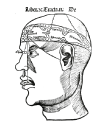Perception
| Psychology |
| History |
| Psychologists |
| Divisions |
|---|
| Abnormal |
| Applied |
| Biological |
| Clinical |
| Cognitive |
| Comparative |
| Developmental |
| Differential |
| Industrial |
| Parapsychology |
| Personality |
| Positive |
| Religion |
| Social |
| Approaches |
| Behaviorism |
| Depth |
| Experimental |
| Gestalt |
| Humanistic |
| Information processing |
| Neuropsychology |
|---|
| Topics |
|
Brain-computer interfaces • Brain damage |
| Brain functions |
|
arousal • attention |
| People |
|
Arthur L. Benton • António Damásio |
| Tests |
|
Bender-Gestalt Test |
| Mind and Brain Portal |
In psychology and the cognitive sciences, perception is the process of acquiring, interpreting, selecting, and organizing sensory information. The word perception comes from the Latin perception-, percepio, , meaning "receiving, collecting, action of taking possession, apprehension with the mind or senses." —OED.com. Methods of studying perception range from essentially biological or physiological approaches, through psychological approaches through the philosophy of mind and in empiricist epistemology, such as that of David Hume, John Locke, George Berkeley, or as in Merleau Ponty's affirmation of perception as the basis of all science and knowledge.
History of the study of perception
Perception is one of the oldest fields within scientific psychology, and there are correspondingly many theories about its underlying processes. The oldest quantitative law in psychology is the Weber-Fechner law, which quantifies the relationship between the intensity of physical stimuli and their perceptual effects. It was the study of perception that gave rise to the Gestalt school of psychology, with its emphasis on holistic approach. .
Perception and reality
Many cognitive psychologists hold that, as we move about in the world, we create a model of how the world works. That is, we sense the objective world, but our sensations map to percepts, and these percepts are provisional, in the same sense that scientific hypotheses are provisional (cf. in the scientific method). As we acquire new information, our percepts shift, thus solidifying the idea that perception is a matter of belief. Abraham Pais' biography refers to the 'esemplastic' nature of imagination. In the case of visual perception, some people can actually see the percept shift in their mind's eye. Others who are not picture thinkers, may not necessarily perceive the 'shape-shifting' as their world changes. The 'esemplastic' nature has been shown by experiment: an ambiguous image has multiple interpretations on the perceptual level.
Just as one object can give rise to multiple percepts, so an object may fail to give rise to any percept at all: if the percept has no grounding in a person's experience, the person may literally not perceive it.
This confusing ambiguity of perception is exploited in human technologies such as camouflage, and also in biological mimicry, for example by Peacock butterflies, whose wings bear eye markings that birds respond to as though they were the eyes of a dangerous predator. Perceptual ambiguity is not restricted to vision. For example, recent touch perception research (Robles-De-La-Torre & Hayward 2001) found that kinesthesia-based haptic perception strongly relies on the forces experienced during touch. This makes it possible to produce illusory touch percepts (see also the MIT Technology Review article The Cutting Edge of Haptics).
Cognitive theories of perception assume there is a poverty of stimulus. This (with reference to perception) is the claim that sensations are, by themselves, unable to provide a unique description of the world. Sensations require 'enriching', which is the role of the mental model. A different type of theory is the perceptual ecology approach of James J. Gibson. Gibson rejected the assumption of a poverty of stimulus by rejecting the notion that perception is based in sensations. Instead, he investigated what information is actually presented to the perceptual systems. He (and the psychologists who work within this paradigm) detailed how the world could be specified to a mobile, exploring organism via the lawful projection of information about the world into energy arrays. Specification is a 1:1 mapping of some aspect of the world into a perceptual array; given such a mapping, no enrichment is required and perception is direct.
Perception-in-Action
The ecological understanding of perception advanced from Gibson's early work is perception-in-action, the notion that perception is a requisite property of animate action, without perception action would not be guided and without action perception would be pointless. Animate actions require perceiving and moving together. In a sense, "perception and movement are two sides of the same coin, the coin is action." (D.N. Lee) A mathematical theory of perception-in-action has been devised and investigated in many forms of controlled movement by many different species of organism, General Tau Theory. According to this theory, tau information, or time-to-goal information is the fundamental 'percept' in perception.
Perception and action
We gather information about the world and interact with it through our actions. Perceptual information is critical for action. Perceptual deficits may lead to profound deficits in action (for touch-perception-related deficits, see Robles-De-La-Torre 2006).
Types of perception
- Amodal perception
- Color perception
- Depth perception
- Form perception
- Haptic perception
- Speech perception
- Perception as Interpretation
- Numeric Value of Perception
- Perceive
References and Further Reading
- Flanagan, J.R., Lederman, S.J. Neurobiology: Feeling bumps and holes, News and Views, Nature, 412(6845):389-91 (2001).
- James.J.Gibson, The Senses Considered as Perceptual Systems. Boston 1966.
- James J. Gibson. The Ecological Approach to Visual Perception. Lawrence Erlbaum Associates, 1987. ISBN 0898599598
- Hayward V, Astley OR, Cruz-Hernandez M, Grant D, Robles-De-La-Torre G. Haptic interfaces and devices. Sensor Review 24(1), pp. 16-29 (2004).
- Robles-De-La-Torre G. & Hayward V. Force Can Overcome Object Geometry In the perception of Shape Through Active Touch. Nature 412 (6845):445-8 (2001).
- Robles-De-La-Torre G. The Importance of the Sense of Touch in Virtual and Real Environments. IEEE Multimedia 13(3), Special issue on Haptic User Interfaces for Multimedia Systems, pp. 24-30 (2006).
External links
- Online papers on perception, by various authors, compiled by David Chalmers
- Paradoxical haptic objects. An example of touch illusions of shape. See also the MIT Technology Review article:
- The Cutting Edge of Haptics, by Duncan Graham-Rowe.
- Theories of Perception
See also
- Apophenia
- Autopoiesis
- Pareidolia
- Psychophysics
- Sensory Neuroscience
- Visual routine
- Illusions
- Deregowski's Cross-Cultural Study on Perception
- Perceptual constancy
ar:إدراك حسي bg:Възприятие cs:Vnímání da:Perception de:Wahrnehmung et:Taju es:Percepción eo:Percepto fr:Perception hy:Ըմբռնում ia:Perception it:Percezione he:תפיסה lt:Suvokimas nl:Perceptie ja:知覚 no:Persepsjon pl:Spostrzeganie pt:Percepção ru:Восприятие ru-sib:Почутте simple:Perception sr:Перцепција fi:Havaitseminen sv:Perception vi:Tri giác tr:Algı uk:Пізнання ur:آگاہی zh:知觉
Credits
New World Encyclopedia writers and editors rewrote and completed the Wikipedia article in accordance with New World Encyclopedia standards. This article abides by terms of the Creative Commons CC-by-sa 3.0 License (CC-by-sa), which may be used and disseminated with proper attribution. Credit is due under the terms of this license that can reference both the New World Encyclopedia contributors and the selfless volunteer contributors of the Wikimedia Foundation. To cite this article click here for a list of acceptable citing formats.The history of earlier contributions by wikipedians is accessible to researchers here:
The history of this article since it was imported to New World Encyclopedia:
Note: Some restrictions may apply to use of individual images which are separately licensed.

